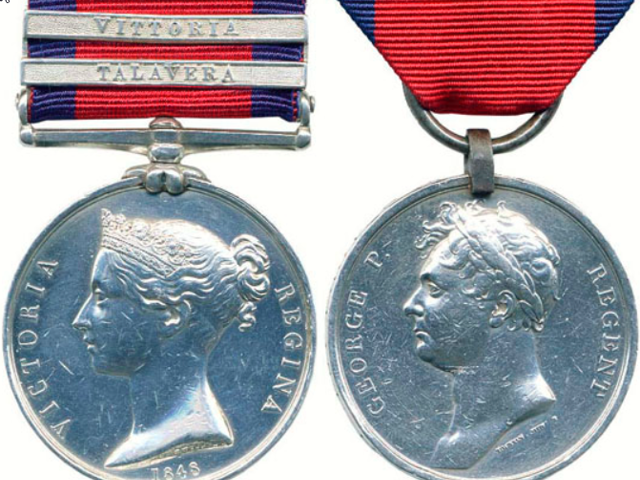James Tibbett - Waterloo Pensioner
James Tibbett’s grave stands in a prominent place in the graveyard at Edlesborough Parish Church, in clear view of travellers along the main road and opposite the Bell and Greyhound Inns. They were both fully licensed inns and both had good accommodation. They were well used by the waggoners who trundled slowly to London with heavy farm produce.
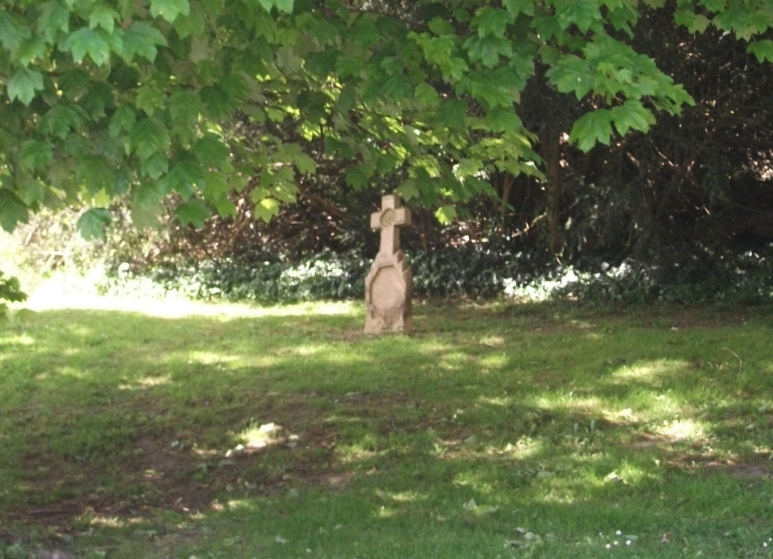
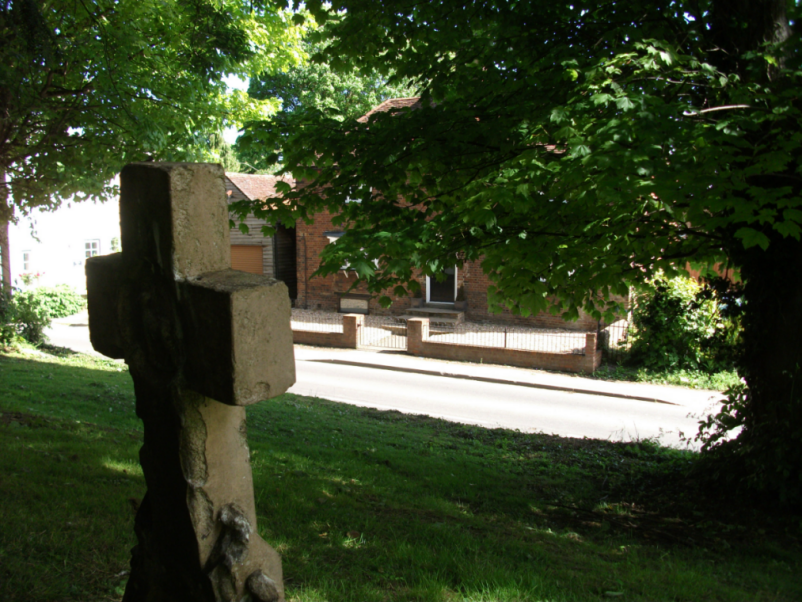
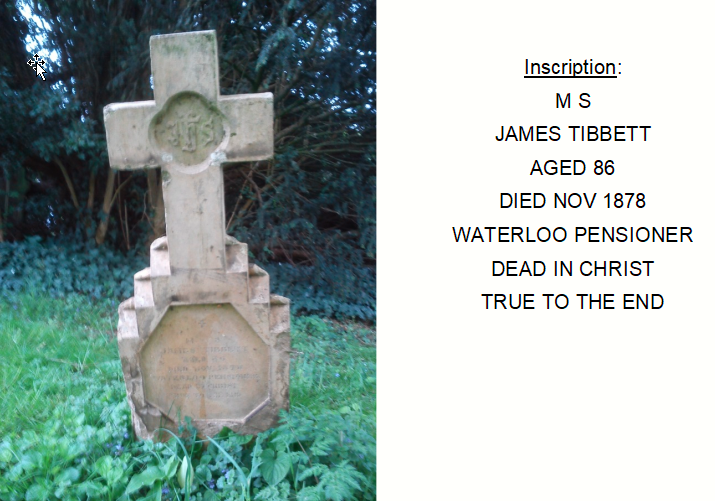
It is believed that the ‘M.S.’ on the headstonecould stand for ‘Memoriae Sacrum’ ie ‘Sacred to the Memory of’.
There are a couple of inconsistencies with the gravestone:
- James was baptised at Edlesborough Parish Church on 2nd March 1794, son of John Tibbett. Infants were usually baptised fairly soon after birth in those days, which could mean that he was probably 84 years old when he died in November 1878.
- James was buried 28th November 1878 and it is fairly unusual for the actual date of death not to be recorded on the tombstone,
- or for “occupations” to be recorded on the tombstone.
Given the above, together with the facts that the family were mainly occupied as straw plaiters and/or agricultural labourers, and that the stone is of high quality compared with most others of that era, it is possible that the money for the gravestone was raised by public subscription rather than by the family. If correct, this stands testament to the regard that his service at the Battle of Waterloo was held by the village. Indeed the following paragraph, written nearly 18 years after his death, implies that his service was celebrated each year.
‘Leighton Buzzard Observer and Linslade Gazette’ - Tuesday 30 June 1896
EDLESBOROUGH - June 18th being Waterloo Day, a wreath of laurel leaves was, as usual placed upon the headstone of the grave of James Tibbett who fought with the Old 14th, a Buckinghamshire Regiment, led by the Earl of Albermarle, at the Battle of Waterloo in 1815.’
(The Earl of Albemarle does not appear in the account of the battle below, but actually he is George Keppel, who is mentioned.)
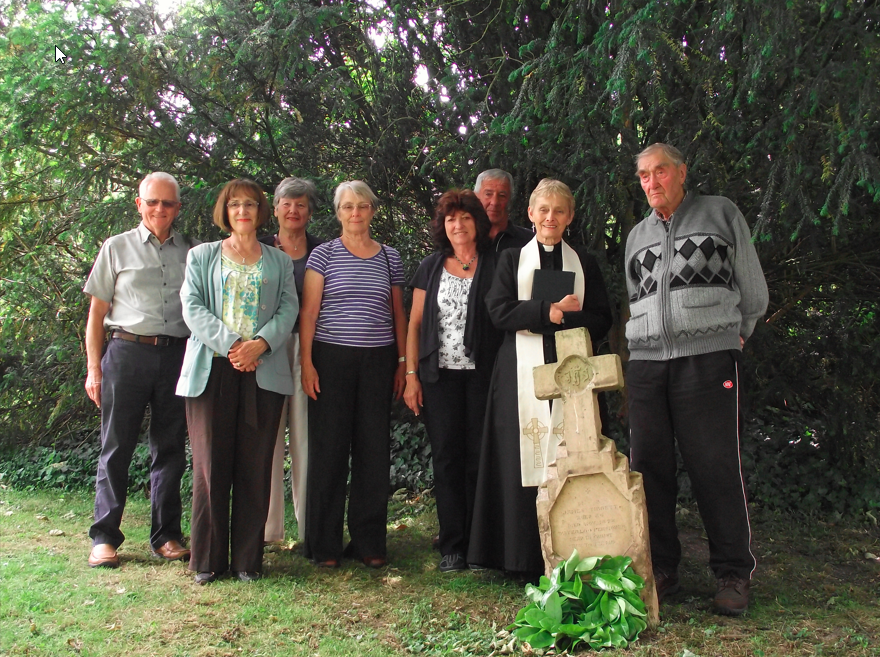
This tradition was repeated in 2015, to mark the 200th anniversary of the Battle. Members of the Friends of the Church on the Hill held a short service and placed a wreath on the gravestone as was done previously.
The gentleman on the right is Mr Jack Horne, who lived opposite the church and, together with his wife, Joan, cared for the graveyard and church for many years. In July 2019 The Churches Conservation Trust presented Jack with a special certificate recognising his and Joan’s long voluntary service.
Jack was our own local hero.
In 1944, he took part in the D-Day landings on Juno Beach, Normandy. He also fought in major battles such as Arnhem and "the Bulge". For his services he was awarded the Legion D'Honneur medal by the French Government.
Jack died in 2023 aged 99, and was given full military honours at his funeral.
Battle of Waterloo:
The Battle of WaterIoo took place on 18th June 1815.
In the early 1800s there were few members of a standing army. The Buckinghamshire regiments at the time of Waterloo (The Bucks Yeomanry, volunteers and militia) were predominantly irregulars intended for defensive purposes at home rather than fighting abroad and so did not therefore fight at Waterloo.
The 14th Regiment of Foot bore the title of the Buckinghamshire Regiment at the time of Waterloo, though only the 3rd Battalion served. Recruitment to the 3rd battalion started in earnest in early December 1813. Most of the men were militiamen rather than raw recruits, partially trained and who had decided that army life was a long term career option for them.
Various militia regiments offered up volunteers to the new battalion, including 3 men from Buckinghamshire Militia who joined up in April 1814.
A search of the Waterloo Medal Book produced the information that James was a Private in the 3rd Battalion 14th Regiment of Foot, in Captain William Bett’s Company.
It is not known whether James was a militiaman or a new recruit.
Ensign George Keppell, who later became the Earl of Albemarle, was gazetted into the 14th on 4th April 1815 at the age of just 16. He was less than impressed with his new colleagues and subordinates. ‘Fourteen of the officers and three hundred of the men were under twenty years of age. These last, consisting principally of Buckinghamshire lads fresh from the plough, were called at home ‘the Bucks,’ but their un-Buckish appearance abroad procured for them the appellation of the ‘Peasants.’
The ‘Peasants’ spent late May and early June in and around the village of Deux-Acren, making friends with the locals, putting their skills to use by weeding flax and corn, and planting that year’s potato crop. It was the calm before the storm.
Napoleon crossed the frontier on 15th June and early the next morning the battalion formed up, bound for Enghien, about fourteen kilometres to the south-east. By 10am it was pouring with rain. The officers and men slept in the mud as best as they could.
On Sunday 18th June the men were woken at 4.30am. It had only just stopped raining and they were covered from head to toe in mud. Sunrise was at half-past five, and the men spent the first hour after sunrise cleaning and drying their arms. Following an inspection of every musket and ammunition-pouch they fell out for breakfast.
They were ordered to advance at about 3pm into an open valley, with the hill opposite fringed by French cannon. They advanced to their new position amid a shower of shot and shell. They were then posted as the right-hand infantry regiment of the British line, with instructions to keep a good look-out on a strong body of the cavalry of the Imperial Guard. They occupied the crest of a gentle hill.
After the battle the British army was ordered south to Nivelle, Belgium, a distance of about fifteen kilometres, and eventually on to Paris, where the battalion spent a pleasant autumn and Christmas.
They went home via Plymouth in January 1816. The third battalion was disbanded at Deal on 17th February 1816, the men fit for duty were transferred to the second battalion.
Every man present on 18th June later received the silver Waterloo Medal. It was the British Army's first campaign medal, given to approximately 39,000 men.
The Waterloo Medal's History and Significance
The Waterloo Medal is an extremely important part of military history for the following four reasons.
- It was issued to all soldiers present at the battle regardless of rank, making it the British Army’s first ‘true’ campaign medal.
- The medal was the first to be engraved with the soldier's name, rank and regiment around the edge - setting a precedent for all future awards.
- The medal’s design, metal and size was repeated on most future British campaign medals.
- It was the first campaign medal awarded to the families and next-of-kin of soldiers killed in action.
James’ Later Life
It is not known whether James returned to Edlesborough then, or whether he had a further career in the army. However this is likely, since the 1871 census states that he was a ‘Waterloo Pensioner’ and it is believed that personnel had to serve a minimum of 12 years to qualify for such an award.
The 1861 census records him as a Straw Plaiter/Plait man. This was perhaps one of the men who prepared the straw by stripping it to lengths of 9-10 inches (about 250 cms), fitting them into pottles (about half a gallon), ready for straw to be bleached and graded before being issued to the straw plaiters, who were usually women and children. His wife and daughter were both straw plaiters.
In the 1871 census he gave his age as 77 years and his occupation as Army Pensioner. Charlotte, age 63, was still a straw plaiter.
He died in November 1878. One can imagine that he was very proud of his medal, possibly the only one in the village.
Charlotte died in 1884 – in the census of 1881 she was living with her daughter, a straw plaiter and son–in-law, an agricultural labourer, in Gray’s Yard in Golden Square. She was recorded as a Pauper.
Sources
- “A Very Pretty Little Battalion”: The 3/14th Regiment of Foot in the Waterloo Campaign By Steve Brown in napolean-series
- Ancestry.com
- Find My Past.co.uk
- Forces War Records.org
- warwick&warwick - re waterloo medals
